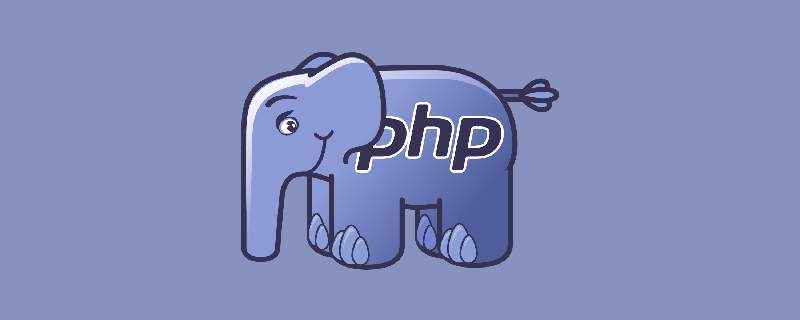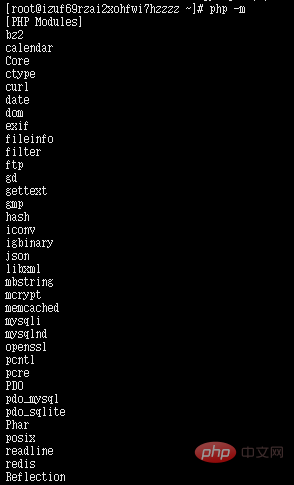How to install php with yum under linux
How to install php with yum under Linux: 1. Update the yum source; 2. Install php7 through the "yum install php70w-common" command; 3. Check the php version through "php -v".

The operating environment of this article: centos7 system, PHP7.0 version, Dell G3 computer
How to install php under yum under linux
Use yum to install the new version of php7.0 under linux
In the past two days, I have installed a virtual machine again, compiled lnmp, and Various extensions are very troublesome. Can they be installed directly with yum? The answer is yes!
#1. First, update the yum source, otherwise it will be the default old version, which is generally 5.6 and below, but php7 has been out for a long time, and the performance has improved by more than 50%!
Update the yum source according to the system. Mine is centos7, so I run the following code!
CentOS/RHEL 7.x:
rpm -Uvh https://dl.fedoraproject.org/pub/epel/epel-release-latest-7.noarch.rpmrpm -Uvh https://mirror.webtatic.com/yum/el7/webtatic-release.rpm
If it is centos6, then execute the following code:
CentOS/RHEL 6.x:
rpm -Uvh https://dl.fedoraproject.org/pub/epel/epel-release-latest-6.noarch.rpmrpm -Uvh https://mirror.webtatic.com/yum/el6/latest.rpm
Then you can install php7.0 directly using yum. The extensions that can be installed are as follows:
yum install php70w-common php70w-fpm php70w-opcache php70w-gd php70w-mysqlnd php70w-mbstring php70w-pecl-redis php70w-pecl-memcached php70w-devel
With just this command, you can install the following extensions!
php-api, php-bz2, php-calendar, php-ctype, php-curl, php-date, php-exif, php-fileinfo, php-filter, php-ftp, php-gettext, php-gmp, php-hash, php-iconv, php-json, php-libxml, php-openssl, php-pcre, php-pecl-Fileinfo, php-pecl-phar, php-pecl-zip, php-reflection, php-session, php-shmop, php-simplexml, php-sockets, php-spl, php-tokenizer, php-zend-abi, php-zip, php-zlib
Are you excited? Don’t worry, there are even better ones! Generally, memcached, gd, mysql, etc. need to be installed, right?
1 安装包 提供的拓展 2 php70w mod_php , php70w-zts 3 php70w-bcmath 4 php70w-cli php-cgi, php-pcntl, php-readline 5 php70w-common php-api, php-bz2, php-calendar, php-ctype, php-curl, php-date, php-exif, php-fileinfo, php-filter, php-ftp, php-gettext, php-gmp, php-hash, php-iconv, php-json, php-libxml, php-openssl, php-pcre, php-pecl-Fileinfo, php-pecl-phar, php-pecl-zip, php-reflection, php-session, php-shmop, php-simplexml , php-sockets, php-spl, php-tokenizer, php-zend-abi, php-zip, php-zlib 6 php70w-dba 7 php70w-devel 8 php70w-embedded php-embedded-devel 9 php70w-enchant 10 php70w-fpm 11 php70w-gd 12 php70w-imap 13 php70w-interbase php_database, php-firebird14 php70w-intl 15 php70w-ldap 16 php70w-mbstring 17 php70w-mcrypt 18 php70w-mysql php-mysqli, php_database19 php70w-mysqlnd php-mysqli, php_database20 php70w-odbc php-pdo_odbc, php_database21 php70w-opcache php70w-pecl-zendopcache22 php70w-pdo php70w-pdo_sqlite, php70w-sqlite323 php70w-pdo_dblib php70w-mssql24 php70w-pear 25 php70w-pecl-apcu 26 php70w-pecl-imagick 27 php70w-pecl-memcached 28 php70w-pecl-mongodb 29 php70w-pecl-redis 30 php70w-pecl-xdebug 31 php70w-pgsql php-pdo_pgsql, php_database32 php70w-phpdbg 33 php70w-process php-posix, php-sysvmsg, php-sysvsem, php-sysvshm34 php70w-pspell 35 php70w-recode 36 php70w-snmp 37 php70w-soap 38 php70w-tidy 39 php70w-xml php-dom, php-domxml, php-wddx, php-xsl40 php70w-xmlrpc
For example, if you want to install xml, you can do it directly. Don’t doubt it is that simple:
yum install php70w-xml
2. Check the result:
Check the php version:
php -v

Check the php extension:

See it? Basically, all the extensions you can use are available, right? If you want anything, just go to yum and it will be fine! No more having to worry about various dependency issues!
Recommended learning: "PHP Video Tutorial"
The above is the detailed content of How to install php with yum under linux. For more information, please follow other related articles on the PHP Chinese website!

Hot AI Tools

Undresser.AI Undress
AI-powered app for creating realistic nude photos

AI Clothes Remover
Online AI tool for removing clothes from photos.

Undress AI Tool
Undress images for free

Clothoff.io
AI clothes remover

Video Face Swap
Swap faces in any video effortlessly with our completely free AI face swap tool!

Hot Article

Hot Tools

Notepad++7.3.1
Easy-to-use and free code editor

SublimeText3 Chinese version
Chinese version, very easy to use

Zend Studio 13.0.1
Powerful PHP integrated development environment

Dreamweaver CS6
Visual web development tools

SublimeText3 Mac version
God-level code editing software (SublimeText3)

Hot Topics
 1664
1664
 14
14
 1423
1423
 52
52
 1319
1319
 25
25
 1269
1269
 29
29
 1248
1248
 24
24
 Linux Architecture: Unveiling the 5 Basic Components
Apr 20, 2025 am 12:04 AM
Linux Architecture: Unveiling the 5 Basic Components
Apr 20, 2025 am 12:04 AM
The five basic components of the Linux system are: 1. Kernel, 2. System library, 3. System utilities, 4. Graphical user interface, 5. Applications. The kernel manages hardware resources, the system library provides precompiled functions, system utilities are used for system management, the GUI provides visual interaction, and applications use these components to implement functions.
 How to check the warehouse address of git
Apr 17, 2025 pm 01:54 PM
How to check the warehouse address of git
Apr 17, 2025 pm 01:54 PM
To view the Git repository address, perform the following steps: 1. Open the command line and navigate to the repository directory; 2. Run the "git remote -v" command; 3. View the repository name in the output and its corresponding address.
 vscode Previous Next Shortcut Key
Apr 15, 2025 pm 10:51 PM
vscode Previous Next Shortcut Key
Apr 15, 2025 pm 10:51 PM
VS Code One-step/Next step shortcut key usage: One-step (backward): Windows/Linux: Ctrl ←; macOS: Cmd ←Next step (forward): Windows/Linux: Ctrl →; macOS: Cmd →
 How to run java code in notepad
Apr 16, 2025 pm 07:39 PM
How to run java code in notepad
Apr 16, 2025 pm 07:39 PM
Although Notepad cannot run Java code directly, it can be achieved by using other tools: using the command line compiler (javac) to generate a bytecode file (filename.class). Use the Java interpreter (java) to interpret bytecode, execute the code, and output the result.
 How to run sublime after writing the code
Apr 16, 2025 am 08:51 AM
How to run sublime after writing the code
Apr 16, 2025 am 08:51 AM
There are six ways to run code in Sublime: through hotkeys, menus, build systems, command lines, set default build systems, and custom build commands, and run individual files/projects by right-clicking on projects/files. The build system availability depends on the installation of Sublime Text.
 What is the main purpose of Linux?
Apr 16, 2025 am 12:19 AM
What is the main purpose of Linux?
Apr 16, 2025 am 12:19 AM
The main uses of Linux include: 1. Server operating system, 2. Embedded system, 3. Desktop operating system, 4. Development and testing environment. Linux excels in these areas, providing stability, security and efficient development tools.
 laravel installation code
Apr 18, 2025 pm 12:30 PM
laravel installation code
Apr 18, 2025 pm 12:30 PM
To install Laravel, follow these steps in sequence: Install Composer (for macOS/Linux and Windows) Install Laravel Installer Create a new project Start Service Access Application (URL: http://127.0.0.1:8000) Set up the database connection (if required)
 git software installation
Apr 17, 2025 am 11:57 AM
git software installation
Apr 17, 2025 am 11:57 AM
Installing Git software includes the following steps: Download the installation package and run the installation package to verify the installation configuration Git installation Git Bash (Windows only)




